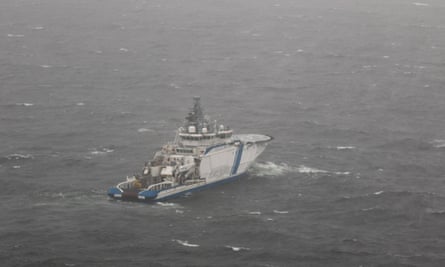Underwater infrastructure vulnerable to Russian threats, says V Adm Didier Maleterre, after suspected sabotage of gas pipelines
The security of nearly 1 billion people across Europe and North America is under threat from Russian attempts to target the extensive vulnerabilities of underwater infrastructure including windfarms, pipelines and power cables, a Nato commander has warned.
V Adm Didier Maleterre, the deputy commander of Nato’s Allied Maritime Command (Marcom), said the network of underwater cables and pipes on which Europe’s power and communications depend were not built to withstand the “hybrid warfare” being pursued by Moscow and other Nato adversaries.
“We know the Russians have developed a lot of hybrid warfare under the sea to disrupt the European economy, through cables, internet cables, pipelines. All of our economy under the sea is under threat,” he said.
“And, to be very clear, we know what Russians have developed as far as nuclear submarines to operate under the sea. So we are not naive and we [Nato countries] are working together.”
The comments come after two incidents of suspected sabotage on gas pipelines in the Baltic in the last 18 months – first on Nord Stream 1 and 2 in September 2022, followed by the Balticconnector in October last year. Despite extensive investigations by multiple states both remain unsolved, although Finland said in December that “everything indicated” a Chinese ship had purposely damaged the Balticconnector with its anchor.
Maleterre, a submariner who said he had himself spent “more than 1,000 days under the sea”, said the environment had changed dramatically since much of the current infrastructure was first developed by the private sector, leaving it extremely vulnerable.
“They [the companies responsible for them] didn’t know that such hybrid warfare would develop so rapidly. More than 90% of [the] internet is under the sea. All our links between the US, Canada and Europe are transmitting under the sea, so there are a lot of vulnerabilities.”
Despite the increasing role of offshore wind power to meet climate goals, the infrastructure still has “system vulnerabilities,” he said. Offshore wind will need to increase by 25% by 2050 to meet EU wind energy capacity targets, according to industry association WindEurope, while the Biden administration wants to deploy 30,000 megawatts of offshore wind along the coastlines of the US by 2030.
At any one time Maleterre said that Marcom had “more than 100 ships, nuclear submarines and conventional submarines” patrolling waters including the Arctic, Black Sea, Atlantic, Baltic and the Mediterranean.
“That’s a very important concern because it’s a security issue for nearly 1 billion Nato-nation civilians. We need to be protected and well supplied by our vital undersea infrastructures.”
But even with a significant presence it was impossible for Nato to guard every piece of undersea infrastructure, he said, with primary responsibility lying with nations to protect their own infrastructure.
“We know there are a lot of vulnerabilities … When we have offshore installation, first of all the responsibilities are in the states’ hands,” he said.
He added: “We have particular attention on the Russians at the moment, but it’s very difficult to have a permanent surveillance of every cable; it’s not possible. A lot of nations – Norway, Sweden, Denmark as well – have developed drones, sensors, UUVs [unmanned underwater vehicles] to be able to detect very rapidly [something] suspicious or something going wrong.”
Such is the heightened nature of fears over undersea security that Nato is in the process of setting up a centre dedicated to the issue at Marcom’s UK-based headquarters in Northwood, on the north-west outskirts of London, alongside Nato’s shipping centre.

Using artificial intelligence software, Marcom can detect and follow suspicious activity at sea, such as ships switching off their automatic identification system (AIS) to prevent them from being traced or loitering in a particular area.
They are also using satellites. “We are using all our sensors from the seabed to space, particularly the satellite capabilities of Nato, to be able to identify suspicious activity,” Maleterre said.
Being able to identify the actors behind hybrid attacks was vital, said Maleterre, but he admitted it could be challenging, comparing it to tracking down the perpetrator of a cyber-attack. “If the Russians are using very high-handed capabilities – and I cannot go into details but we are talking about submarines and nuclear submarines – that’s very, very tough; very difficult,” he said.
The addition of Finland to Nato’s fleet last year, and more recently that of Sweden, which became a full Nato member in March, is seen as especially important for the protection of the Baltic and Arctic. Sweden’s experience in both regions “will immediately increase Nato’s ability to detect and deter any regional aggression.
“And when we talk about aggression, we think about Russia obviously,” added Maleterre, who said Sweden’s membership in particular brought submarines, mine warfare ships, special forces and fast, powerful boats.
Source: The Guardian

